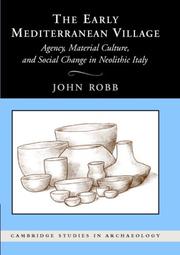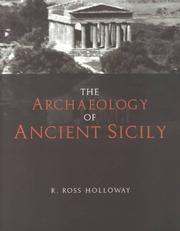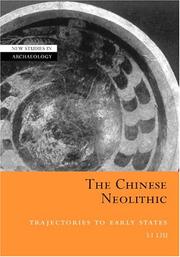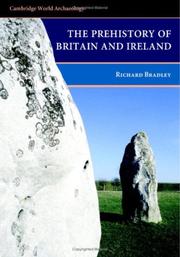| Listing 1 - 10 of 76 | << page >> |
Sort by
|

ISBN: 9780521842419 0521842417 9780511499647 9781107661103 9780511342356 0511342357 0511499647 1107661102 110717516X 128108493X 9786611084936 1139130927 0511341822 0511341288 0511340702 Year: 2007 Volume: *3 Publisher: Cambridge New York Cambridge University Press
Abstract | Keywords | Export | Availability | Bookmark
 Loading...
Loading...Choose an application
- Reference Manager
- EndNote
- RefWorks (Direct export to RefWorks)
What was daily life like in Italy between 6000 and 3500 BC? In this book, first published in 2007, John Robb brings together the archaeological evidence on a wide range of aspects of life in Neolithic Italy and surrounding regions (Sicily and Malta). Exploring how the routines of daily life structured social relations and human experience during this period, Robb provides a detailed analysis of how people built houses, buried their dead, made and shared a distinctive cuisine, and made the pots and stone tools that archaeologists find. He also addresses questions of regional variation and long-term change, showing how the sweeping changes at the end of the Neolithic were rooted in and transformed the daily practices of earlier periods. Robb links the agency of daily life and the reproduction of social relations with long-term patterns in European prehistory.
Antiquities, Prehistoric --- Neolithic period --- Prehistoric antiquities --- Prehistoric archaeology --- Prehistory --- Prehistoric peoples --- Italy --- Antiquities. --- Social Sciences --- Archeology

ISBN: 1134557736 1280045639 0585453284 9786610045631 0203469623 9780585453286 0415237912 1134557728 9780415237918 Year: 1991 Publisher: London New York Routledge
Abstract | Keywords | Export | Availability | Bookmark
 Loading...
Loading...Choose an application
- Reference Manager
- EndNote
- RefWorks (Direct export to RefWorks)
The standard work on the archaeology of ancient Sicily, Holloway's now updated study provides the only comprehensive introduction to the wealth of artefacts and monuments discovered on the island.
Antiquities, Prehistoric --- Excavations (Archaeology) --- Prehistoric antiquities --- Prehistoric archaeology --- Prehistory --- Prehistoric peoples --- Sicily (Italy) --- Antiquities.
Book
ISBN: 9088901767 9789088901768 9789088900808 9088900809 Year: 2012 Publisher: Leiden Sidestone Press
Abstract | Keywords | Export | Availability | Bookmark
 Loading...
Loading...Choose an application
- Reference Manager
- EndNote
- RefWorks (Direct export to RefWorks)
DUTCH DESCRIPTION: In het werk en onderzoek van Eric Lohof staat de Nederlandse prehistorie centraal, en die van het Neolithicum en de Bronstijd in het bijzonder. Ter ere van Eric's pensioen in 2011 is rondom dit onderwerp een feestbundel samengesteld met bijdragen van vrienden, collega's en vakgenoten. In deze bijzondere samenwerking tussen archeologen uit de academische wereld en de private sector is een dwarsdoorsnede geschetst van wat de Nederlandse prehistorische archeologie te bieden heeft. Het richt zich op de nieuwe technische ontwikkelingen in het steentijdonderzoek en op de mogelijkh
Tombs. --- Antiquities, Prehistoric. --- Prehistoric antiquities --- Prehistoric archaeology --- Prehistory --- Prehistoric peoples --- Archeology --- Netherlands
Book
ISBN: 2271090997 Year: 2016 Publisher: Paris : CNRS Éditions,
Abstract | Keywords | Export | Availability | Bookmark
 Loading...
Loading...Choose an application
- Reference Manager
- EndNote
- RefWorks (Direct export to RefWorks)
La préhistoire, une passion française… qui remonte à la Révolution et aux premières tentatives d’organisation de la recherche archéologique. La fièvre préhistorienne culmine au XIXe siècle : fouilles sauvages, commerce illégal de monuments mégalithiques, archéologues du dimanche… Mais aussi paysans occupés à paver les rues de leur village avec les menhirs de Carnac ! Il faudra attendre 1941 pour que l’État réglemente les fouilles archéologiques. Cet ouvrage retrace la longue marche des archéologues français vers l’institutionnalisation de leur discipline, aventure passionnante qui vit les préhistoriens se mobiliser contre les pouvoirs publics pour préserver leur liberté d’agir.
Antiquities, Prehistoric --- France --- Antiquities. --- Prehistoric antiquities --- Prehistoric archaeology --- Prehistory --- Prehistoric peoples --- archéologie --- préhistoire --- histoire --- politique

ISBN: 0521811848 0521010640 1107132711 0511170653 0511080565 0511331266 0511489625 1280419598 0511206593 051107980X 9780511080562 9780511489624 9780511079801 9781280419591 9786610419593 6610419590 9780521811842 9780521010641 Year: 2004 Volume: *28 Publisher: Cambridge Cambridge University Press
Abstract | Keywords | Export | Availability | Bookmark
 Loading...
Loading...Choose an application
- Reference Manager
- EndNote
- RefWorks (Direct export to RefWorks)
This book studies the formation of complex societies in prehistoric China during the Neolithic and early state periods, c. 7000-1500 BC. Archaeological materials are interpreted through anthropological perspectives, using systematic analytic methods in settlement and burial patterns. Both agency and process are considered in the development of chiefdoms and in the emergence of early states in the Yellow River region. Interrelationships between factors such as mortuary practice, craft specialization, ritual activities, warfare, exchange of elite goods, climatic fluctuations, and environmental changes are emphasized. This study offers a critical evaluation of current archaeological data from Chinese sources, and argues that, although some general tendencies are noted, social changes were affected by multiple factors in no pre-determined sequence. In this most comprehensive study to date, Li Liu attempts to reconstruct developmental trajectories toward early states in Chinese civilization and discusses theoretical implications of Chinese archaeology for the understanding of social evolution.
Antiquities, Prehistoric --- Neolithic period --- Prehistoric antiquities --- Prehistoric archaeology --- Prehistory --- Prehistoric peoples --- China --- Antiquities. --- Antiquities [Prehistoric ] --- Antiquities --- Social Sciences --- Archeology

ISBN: 9780521848114 0521848113 9780521612708 0521612705 9780511618574 9780511279096 0511279094 0511276095 9780511276095 0511278497 9780511278495 0511618573 9780511277313 0511277318 9786610850327 6610850321 1107164575 1280850329 0511323026 0511277903 Year: 2007 Publisher: Cambridge New York Cambridge University Press
Abstract | Keywords | Export | Availability | Bookmark
 Loading...
Loading...Choose an application
- Reference Manager
- EndNote
- RefWorks (Direct export to RefWorks)
Sited at the furthest limits of the Neolithic revolution and standing at the confluence of the two great sea routes of prehistory, Britain and Ireland are distinct from continental Europe for much of the prehistoric sequence. In this landmark 2007 study - the first significant survey of the archaeology of Britain and Ireland for twenty years - Richard Bradley offers an interpretation of the unique archaeological record of these islands based on a wealth of current and largely unpublished data. Bradley surveys the entire archaeological sequence over a 4,000 year period, from the adoption of agriculture in the Neolithic period to the discovery of Britain and Ireland by travellers from the Mediterranean during the later pre-Roman Iron Age. Significantly, this is the first modern account to treat Britain and Ireland on equal terms, offering a detailed interpretation of the prehistory of both islands.
Antiquities, Prehistoric --- Excavations (Archaeology) --- Prehistoric peoples --- Prehistoric antiquities --- Prehistoric archaeology --- Prehistory --- Great Britain --- Ireland --- Antiquities. --- Social Sciences --- Archeology
Book
ISBN: 1921666064 1921666072 9781921666070 9781921666063 Year: 2009 Publisher: Canberra, ACT ANU E Press
Abstract | Keywords | Export | Availability | Bookmark
 Loading...
Loading...Choose an application
- Reference Manager
- EndNote
- RefWorks (Direct export to RefWorks)
Antiquities, Prehistoric - Fiji. --- Antiquities, Prehistoric --- Anthropology --- Social Sciences --- Prehistoric Anthropology --- Fiji --- Antiquities. --- Prehistoric antiquities --- Prehistoric archaeology --- Prehistory --- Prehistoric peoples
Book
ISBN: 9780521644327 9780521643108 9781139015301 9781139421409 1139421409 9781139423458 1139423452 1139015303 1139419366 9781139419369 0521643104 0521644321 9781139419369 1139417312 9781139417310 110722442X Year: 2012 Volume: *22 Publisher: Cambridge
Abstract | Keywords | Export | Availability | Bookmark
 Loading...
Loading...Choose an application
- Reference Manager
- EndNote
- RefWorks (Direct export to RefWorks)
"Past, present and future "The archaeological materials recovered from the Anyang excavations ... in the period between 1928 and 1937...have laid a new foundation for the study of ancient China (Li, C. 1977: ix)." When inscribed oracle bones and enormous material remains were found through scientific excavation in Anyang in 1928, the historicity of the Shang dynasty was confirmed beyond dispute for the first time (Li, C. 1977: ix-xi). This excavation thus marked the beginning of a modern Chinese archaeology endowed with great potential to reveal much of China's ancient history.. Half a century later, Chinese archaeology had made many unprecedented discoveries which surprised the world, leading Glyn Daniel to believe that "a new awareness of the importance of China will be a key development in archaeology in the decades ahead (Daniel 1981: 211). This enthusiasm was soon shared by the Chinese archaeologists when Su Bingqi announced that "the Golden Age of Chinese archaeology is arriving (Su, B. 1994: 139--140)". In recent decades, archaeology has continuously prospered, becoming one of the most rapidly developing fields in social science in China"--
S17/0211 --- China: Art and archaeology--Archaeology: Prehistory --- Antiquities, Prehistoric --- Archaeology --- Prehistoric peoples --- Archeology --- Anthropology --- Auxiliary sciences of history --- History --- Antiquities --- Prehistoric antiquities --- Prehistoric archaeology --- Prehistory --- Social Sciences
Book
ISBN: 1623492289 1623492017 1322883963 9781623492281 9781623492014 Year: 2014 Publisher: College Station
Abstract | Keywords | Export | Availability | Bookmark
 Loading...
Loading...Choose an application
- Reference Manager
- EndNote
- RefWorks (Direct export to RefWorks)
Clovis culture --- Antiquities, Prehistoric --- Clovis points --- Clovis blades --- Prehistoric antiquities --- Prehistoric archaeology --- Prehistory --- Indians of North America --- Projectile points --- Stone implements --- Prehistoric peoples --- Paleo-Indians --- Implements
Book
ISBN: 9838616923 9789838616928 9789838615341 983861534X Year: 2012 Publisher: Pulau Pinang
Abstract | Keywords | Export | Availability | Bookmark
 Loading...
Loading...Choose an application
- Reference Manager
- EndNote
- RefWorks (Direct export to RefWorks)
Archaeology and history --- Antiquities, Prehistoric --- Prehistoric antiquities --- Prehistoric archaeology --- Prehistory --- Prehistoric peoples --- Historical archaeology --- History and archaeology --- History --- Malaysia --- Civilization --- History.
| Listing 1 - 10 of 76 | << page >> |
Sort by
|

 Search
Search Feedback
Feedback About UniCat
About UniCat  Help
Help News
News